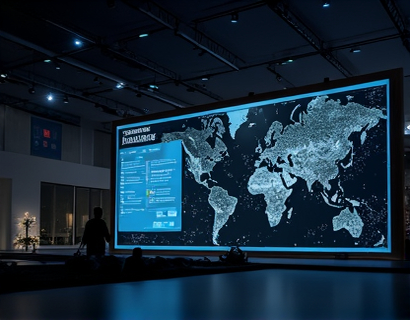Next-Gen QR Code Technology: Revolutionizing Business and Social Media Engagement for Modern Enterprises
In the rapidly evolving digital landscape, businesses and social media managers are constantly seeking innovative solutions to enhance engagement and streamline interactions with their audience. One such technology that has emerged as a game-changer is next-generation QR code technology. This advanced form of QR codes is not just an improvement over the traditional version but a complete reimagining of how information can be shared, accessed, and interacted with. These next-gen QR codes are customizable, intuitive, and designed to revolutionize the way modern enterprises connect with their audience, making them an essential tool for anyone looking to boost their digital presence and foster deeper relationships with customers and followers.
The evolution of QR codes from simple black and white squares to sophisticated, multi-functional tools reflects the broader trends in digital technology. Traditional QR codes have been widely used for tasks such as product information, coupon redemption, and website linking. However, they often lacked the flexibility and depth required in today's complex digital environment. Next-gen QR codes address these limitations by incorporating advanced features that make them more versatile and user-friendly. These codes can store a vast amount of data, including text, URLs, images, videos, and even 3D models, all accessible through a single scan. This capability opens up a myriad of possibilities for businesses and social media managers to engage their audience in more meaningful and interactive ways.
Enhanced Data Storage and Accessibility
One of the most significant advantages of next-gen QR codes is their enhanced data storage capacity. Unlike traditional QR codes, which are limited to a few hundred characters of data, next-gen versions can hold thousands of characters. This increased capacity allows businesses to include detailed information such as comprehensive product descriptions, extensive FAQs, and even interactive content like quizzes and polls. For instance, a retail brand can embed a next-gen QR code on a product label that, when scanned, not only provides basic product information but also offers a video demonstration, customer reviews, and a direct link to purchase the item online. This level of detail and interactivity not only enhances the customer experience but also increases the likelihood of conversion.
Moreover, the accessibility of next-gen QR codes is unparalleled. These codes can be designed to be visually appealing and can blend seamlessly into various marketing materials, from business cards to billboards. The use of custom colors, shapes, and even animations makes the QR codes more engaging and memorable. For social media managers, this means they can create unique and shareable content that stands out in a crowded feed. For example, a brand can design a QR code that changes color or shape based on the device used to scan it, adding an element of surprise and interactivity that encourages users to engage more deeply with the content.
Customization and Brand Integration
Customization is a key feature of next-gen QR codes, allowing businesses to align these codes with their brand identity. Traditional QR codes are often seen as generic and unbranded, which can detract from a brand's overall image. Next-gen QR codes, however, can be tailored to match a brand's color scheme, logo, and even typography. This level of customization ensures that the QR code is not just a functional element but also a branding tool. For instance, a luxury fashion brand can create a QR code that matches its elegant and sophisticated aesthetic, reinforcing the brand's high-end image every time a customer interacts with it.
Furthermore, the customization options extend beyond visual elements to include functional personalization. Businesses can create QR codes that direct users to specific landing pages, offer personalized content based on user data, or even track user interactions in real-time. This level of personalization and tracking provides valuable insights into customer behavior, helping businesses refine their marketing strategies and improve customer engagement. For social media managers, this means they can create targeted campaigns that resonate more deeply with their audience, leading to higher engagement rates and better ROI.
Multi-Platform Compatibility
Next-gen QR codes are designed to be universally accessible, working seamlessly across various devices and platforms. This compatibility is crucial in a world where users access content through a multitude of devices, from smartphones and tablets to smartwatches and AR-enabled glasses. The ability to scan a QR code and instantly access the linked content, regardless of the device, ensures a consistent and smooth user experience. For businesses, this means they can reach their audience wherever they are, whether in-store, online, or on-the-go.
For example, a travel company can embed a next-gen QR code in a print advertisement that, when scanned on a smartphone, opens a virtual tour of a destination. The same QR code can be optimized for a tablet or desktop, providing a more detailed interactive experience. This multi-platform compatibility ensures that the engagement is consistent and effective, no matter how the user chooses to interact with the content.
Enhanced Security and Trust
Security is a critical concern in the digital age, and next-gen QR codes address this by incorporating advanced security features. These codes can include encrypted links, secure access codes, and even biometric verification options, ensuring that the content accessed through the QR code is safe and trustworthy. For businesses, this added layer of security can help build trust with customers, especially when dealing with sensitive information such as financial data or personal details.
For instance, a financial institution can use a next-gen QR code to provide customers with a secure link to their online banking portal. The QR code can be set up to require a one-time password or biometric authentication, ensuring that only authorized users can access their accounts. This not only enhances security but also provides a seamless and secure user experience, which is crucial for maintaining customer trust.
Interactive and Immersive Experiences
One of the most exciting aspects of next-gen QR codes is their ability to create interactive and immersive experiences. By linking to augmented reality (AR) content, 3D models, and interactive videos, businesses can offer users a more engaging and memorable experience. This level of interactivity can significantly enhance customer engagement and brand loyalty.
For example, an automotive brand can use a next-gen QR code on a billboard that, when scanned with a smartphone, triggers an AR experience showing a 3D model of the car. Users can rotate the car, explore its features, and even take a virtual test drive. This immersive experience not only captures the user's attention but also provides a deeper understanding of the product, increasing the likelihood of a purchase. For social media managers, creating such interactive content can lead to higher engagement rates, more shares, and a stronger online presence.
Real-Time Analytics and Insights
Next-gen QR codes often come with built-in analytics tools that provide real-time insights into user interactions. Businesses can track how many times a QR code has been scanned, where the scans are coming from, and even gather data on user behavior once they access the linked content. This data is invaluable for understanding the effectiveness of marketing campaigns and making data-driven decisions to optimize future efforts.
For instance, a retail brand can use the analytics provided by next-gen QR codes to monitor the performance of in-store promotions. By analyzing scan data, the brand can identify which products are generating the most interest, which locations are performing best, and which types of content are most engaging. This information can then be used to refine marketing strategies, improve store layouts, and create more targeted campaigns. For social media managers, real-time analytics can help them gauge the success of social media campaigns and adjust their strategies on the fly to maximize engagement.
Environmental and Cost Efficiency
Next-gen QR codes also offer environmental and cost benefits. Traditional marketing materials such as flyers, brochures, and posters often require significant resources to produce and distribute. In contrast, QR codes can serve as a digital alternative, reducing the need for physical materials and the associated environmental impact. Additionally, the cost of printing and distributing physical materials can be substantial, whereas QR codes can be easily generated and shared digitally, saving businesses money and resources.
For example, a real estate agency can replace printed brochures with QR codes on their website or in digital ads. When potential buyers scan the QR code, they are directed to a virtual tour of the property, complete with detailed information and contact details. This not only reduces the need for physical brochures but also provides a more dynamic and engaging way to showcase properties. The cost savings and environmental benefits make next-gen QR codes an attractive option for businesses looking to be more sustainable and cost-effective.
Conclusion
Next-gen QR code technology represents a significant leap forward in how businesses and social media managers can engage with their audience. By offering enhanced data storage, customization options, multi-platform compatibility, advanced security, interactive experiences, real-time analytics, and cost and environmental efficiency, these codes provide a powerful tool for modern enterprises. As the digital landscape continues to evolve, embracing next-gen QR code technology can help businesses stay ahead of the curve, fostering deeper connections with their audience and driving meaningful growth.










































